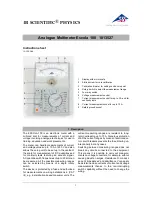
5
TECHNICAL DATA
Dimensions:
70 mm x 70 mm x 45 mm
Supply:
15...24V DC 35mA without load
DMX IN:
1 Unit Load
DMX OUT:
>20 Unit Load, buffered
Analog Out:
0.4...+10.4V, typ. 2mA, max. 4 mA
Order code:
3006A-EP
CE CONFORMITY
This DMX demultiplexer is microprocessor controlled and uses high frequence (16 MHz quartz). The
interface has been tested in our emc lab to comply with EN5022B and IEC65/144.
To ensure the best performance regarding radiated and conducted emissions
we suggest to install the interface card in a closed, conductive (e.g. metal)
housing, which must be connected to GND.
Please make sure that shielded data cable is used and the shield is
connected properly to the GND pin. Shield must never make contact to other
signal lines.
FCC STATEMENT
This product has been tested and complies with the specifications for a Class B digital device,
pursuant to Part 15 of the FCC Rules. These limits are designed to provide reasonable protection
against harmful interference in a residential installation. This equipment generates, uses, and can
radiate radio frequency energy and, if not installed and used according to the instructions, may
cause harmful interference to radio communications.
However, there is no guarantee that interference will not occur in a particular installation. If this
equipment does cause harmful interference to radio or television reception, which is found by turning
the equipment off and on, the user is encouraged to try to correct the interference by one or more of
the following measures:
• Reorient or relocate the receiving antenna
• Increase the separation between the equipment or devices
• Connect the equipment to an outlet other than the receiver's
• Consult a dealer or an experienced radio/TV technician for assistance
FCC Caution: Any change or modification to the product not expressly approved by SLH could void
the user’s authority to operate the device.
DISTURBANCES
If a trouble-free operation cannot be guaranteed, disconnect the decoder interface and secure it
against unwanted operation. This is especially necessary, when
- the unit shows visible damages;
- the unit does not operate;
- internal parts are loose;
- interconnection cables show visible damages.


























